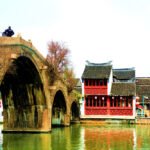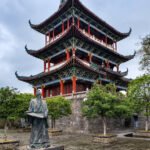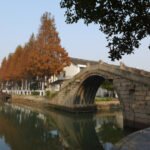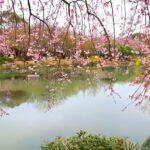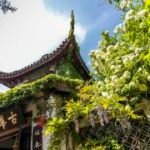Luzhi Ancient Town is located 25 kilometers southeast of Suzhou city proper. There are fewer tourists than in other popular water towns. It is suitable for a casual stroll on weekends. Cross several ‘two bridges in three steps’ (i.e., double bridges) in the ‘town of bridges’. See the buildings with white walls and black tiles by the river and look for the location where the story ‘Harvesting Three to Five Bushels More’ in middle school Chinese textbooks took place. Luzhi Ancient Town was originally named Fuli because there was ‘Fuli Pond’ in the west of the town. Later, because there was a straight port in the east of the town leading to six places, and the shape of the water flow resembled the character ‘lu’. It was renamed ‘Luzhi’. The ancient town is as old as the ancient city of Suzhou and has a history of more than 2,500 years, much older than Zhouzhuang and Tongli ancient towns, which also belong to Suzhou. If you want to buy a joint ticket for small scenic spots, you can enter from the main entrance of Luzhi Ancient Town on Xiaoshi Road. The ticket office is there. If you don’t buy a ticket, you can enter the ancient town from any road. Since the ancient town is not large, there is only one main street – Nanshi Shangtang Street and Nanshi Xiatang Street. No matter where you enter from, you have to come to the main street running from north to south. The scenic spots are mainly on both sides of the main street. To the west of the northern section of the main street is the Xiao Residence, which was built during the Guangxu period of the Qing Dynasty. To the east is a memorial hall with Qing Dynasty architectural style. To the west of the middle section of the main street is the Baosheng Temple. To the south of the temple is the Shen Residence, a large Qing Dynasty luxury residence that already appears very large even though only part of it is open. To the east of the middle section of the main street is the newly-built garden Jiangnan Cultural Park. Inside, the Luzhi History and Cultural Relics Museum displaying unearthed cultural relics from the Chenghu Site confirms the long history of Luzhi. The Luzhi Water Town Women’s Clothing Museum displays unique Luzhi women’s clothing such as headscarves and clothes made of blue calico patches. Located in the town center, near the northwest corner of Jiangnan Cultural Park, are Sanyuan Bridge and Wan’an Bridge, representatives of the ‘two bridges in three steps’ in the ancient town. The southern end of the main street is Wansheng Rice Shop (Luzhi Water Town Farm Tools Museum) transformed according to the article, restoring the layout of the rice shop and exhibiting various farm tools. Among them, Baosheng Temple is a scenic spot worth seeing in the ancient town. It was built in the second year of Tianjian in the Liang Dynasty (503 AD) and has a history of more than 1,500 years. The nine clay sculptures of arhats made by famous Tang Dynasty artists in the ancient relics hall of the temple are very precious. Unlike the arhats in other temples that are listlessly arranged on both sides of the main hall without background embellishment, the arhats here are doing their own things in front of the background of landscape carvings, vividly. To the west of Baosheng Temple is the shrine of a poet from the late Tang Dynasty. If you want to watch traditional folk art, there are performances at 10:00, 13:30, and 15:00 every day on the ancient stage in Jiangnan Cultural Park. If you want to take a boat tour of the ancient town, 100 meters east of the ancient town ticket office, there is a cruise ship dock. Each boat costs 150 yuan and can seat 4 people. A tour takes about 30 minutes. Note that the cruise ship needs to be paid for one boat at a time. One payment is 150 yuan. There are no individual tickets. You can find other tourists to share a boat and then share the cost with everyone.
Numerous tourists dressed in traditional costumes can be seen taking photos in the ancient town, and you can also join in the traditional costume photography by paying a fee. If you wish to taste the local delicacies of the ancient town, you can visit the side streets south of the main street—Xihu Shangtang Street and Xihu Xiatang Street along the river, where numerous shops are lined up, offering specialties such as Fuli Trotters, Fuli Duck, and Aozi Noodles. After September, fresh star anise red water chestnuts become available in Luzhi Ancient Town. For purchasing local specialties, Luzhi dried radish is a good choice, especially the small, round ones. Accommodation is available within Luzhi Ancient Town, but since it’s possible to return to the urban areas of Suzhou or Shanghai on the same day of visiting, accommodation is not very necessary. If you do wish to stay overnight, it is recommended to stay in the Composition Museum, which is filled with the aroma of books, featuring desks and chairs used for reading, as well as old composition books and newspapers, with essays posted on the walls. The museum is open all year round from 08:30 to 17:00, and the ancient town streets are free of charge. The operating hours for various attractions within the ancient town are disclosed separately, and boat rides are available from 8:30 to 16:30. Preferential policies include: Children under 1.4 meters tall are admitted for free; children over 1.4 meters tall and under 18 years old (with a valid ID or household registration book) are admitted for free; students with a student ID can enjoy student discounts; seniors over 70 years old (with valid ID, such as an ID card or senior card) are admitted for free; seniors aged 60 to 69 (with valid ID) can purchase senior tickets; military personnel, retired military officers (non-commissioned officers), and those receiving national pension subsidies can enter for free with valid ID; Suzhou medical staff can enter for free with a ‘Suzhou Medical Staff Garden Card’ and their ID during the week of International Nurses Day on May 12th and Chinese Physician Day on August 19th; persons with a disability certificate and one accompanying person for severely disabled individuals can enter for free; individuals with the National Voluntary Blood Donation Award, Voluntary Hematopoietic Stem Cell Donation Award, and Lifelong Honorary Volunteer Blood Donation Service Award can enter for free; active, retired, and disabled firefighters, as well as fire rescue academy students and full-time firefighters from the government, can enter for free; holders of the ‘Jiangsu Province Honor Certificate for Just and Courageous Actions’ can enter for free; model workers from Wuzhong District and Suzhou sanitation honor certificate holders can enter for free; and holders of the Wuzhong District Tourism Bureau preferential card can enter for free. Service facilities include a parking lot: [Luzhi Ancient Town Parking Lot], with a reference price of ¥10 per entry, located next to the visitor center, and a capacity of 150. WIFI: Account: Taihu_Travel; Password: No password; Coverage: Tourist Service Center of the Scenic Area. Mobile phone charging: Fast charging services are provided in the tourist service center hall. Guided tours: The scenic area offers guided tours.

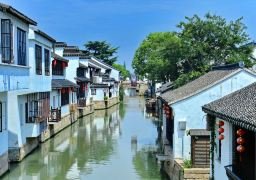
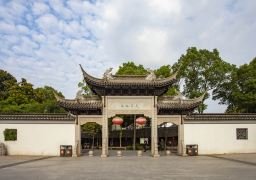
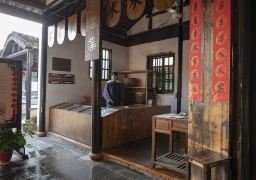
Entrance Fee: 80 RMB per visit. Operating Hours: 8:30 AM – 4:00 PM. Transportation within the park: Reference price: 150 RMB per boat; Address: Luzhi Ancient Town Visitor Center Dock or Wan Sheng Rice Mill Dock; Routes: Luzhi Ancient Town Visitor Center – Wan Sheng Rice Mill Dock or Wan Sheng Rice Mill Dock – Luzhi Ancient Town Visitor Center Dock. Restrooms: Multiple restrooms are available within the Luzhi Ancient Town scenic area, located near the Visitor Center lobby, Luduan Square, beside the Cultural Garden Water Town Clothing Museum, next to the Ancient Stage, opposite the Zhengyuan Road Cultural Station, beside the Sanyuan Bridge, and next to the Celebrity Museum at the Bird Boat Dock, all marked with conspicuous signs.

